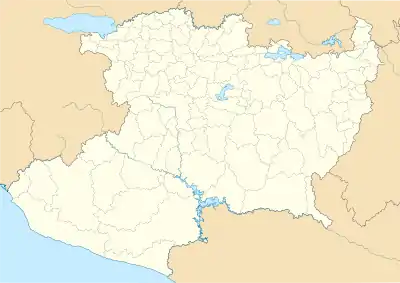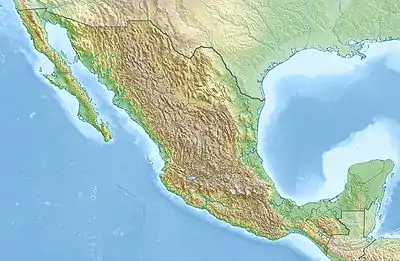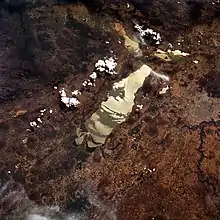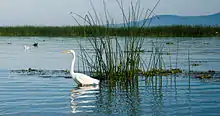| Lake Chapala | |
|---|---|
 | |
 Lake Chapala  Lake Chapala  Lake Chapala | |
| Location | Jalisco / Michoacán, Mexico |
| Coordinates | 20°15′N 103°00′W / 20.250°N 103.000°W |
| Primary inflows | Río Lerma, Río Zula, Río Huaracha, Río Duero |
| Primary outflows | Río Grande de Santiago |
| Basin countries | Mexico |
| Max. length | 80 km (50 mi) |
| Max. width | 18 km (11 mi) |
| Surface area | 1,100 km2 (420 sq mi) |
| Average depth | 7 m (23 ft) |
| Max. depth | 10.5 m (34 ft) |
| Water volume | 8.1 km3 (1.9 cu mi) |
| Surface elevation | 1,524 m (5,000 ft) |
| Islands | 3 |
| Official name | Lago de Chapala |
| Designated | 2 February 2009 |
| Reference no. | 1973[1] |

Lake Chapala (Spanish: Lago de Chapala, [tʃaˈpala] ⓘ) has been Mexico's largest freshwater lake ever since the desiccation of Lake Texcoco.[2]
It borders both the states of Jalisco and Michoacán, being located within the municipalities of Ocotlán, Chapala, Jocotepec, Poncitlán, and Jamay, in Jalisco, and in Venustiano Carranza and Cojumatlán de Régules, in Michoacán.
Geography
Geographic features
It is located at 20°20′N 103°00′W / 20.333°N 103.000°W, 45 kilometres (28 mi) southeast of Guadalajara, Jalisco, and is situated on the border between the states of Jalisco and Michoacán, at 1,524 metres (5000 feet) above sea level. Its approximate dimensions are 80 km (50 mi) from east to west and averages 12.5 km (7.8 miles) from north to south, and covers an approximate area of 1,100 km2 (420 sq mi).[2]
It is a shallow lake, with a mean depth of 7 metres (23 ft)[3] and a maximum of 10.5 m (34 ft). Located in one of the youngest geological areas of the American continent, the age of Lake Chapala has been established by means of Carbon 14 dating of wood samples encountered in the sediments. These specimens indicate an age of 38,000 years, establishing the lake as occurring in late Pleistocene time, a geological epoch that spanned 1,000,000 to 25,000 years ago.[4]
It is fed by the Río Lerma, Río Zula, Río Huaracha, and Río Duero rivers, and drained by the Rio Grande de Santiago. The water then would normally flow northwest into the Pacific Ocean. No water has flowed out of the lake in over 30 years due to a fall in the supply of incoming water from the Lerma River.
Islands
The lake contains three small islands: Isla de los Alacranes (most visible from the town of Chapala), Isla Mezcala (the largest island, featuring an old Spanish fort and an old Mexican prison),[5] and a third very small island[6] next to Isla Mezcala called La Isla Menor.
Mountains
There are many mountains and sierras that surround Lake Chapala: Cerro Viejo-Chupinaya-Los Sabinos (Sierra San Juan Cosalá), Cerro San Miguel-Chiquihuitillo, Cerro San Bartolo-Los Ocotes, Cerro Gomeño, Cerro de García-Del Picacho-El Gachupín (Sierra del Tigre).[7]
Ecology
The city of Guadalajara has relied on Lake Chapala as a principal source of water since the 1950s.[2] Shortly after, a few consecutive years of poor rainfall dramatically decreased the water level of the lake. The level rebounded until 1979, when Lake Chapala's water level began rapidly decreasing due to increases in urban water consumption.
Erosion due to deforestation along the lake as well as the Lerma River has led to increased sedimentation of the lake, also contributing to loss of lake depth. The shrinking depth has also raised the lake's average temperature, resulting in increased evaporation.
Simultaneously, the waters of Lake Chapala are polluted by municipal, industrial and agricultural wastes, coming primarily from the Lerma River. The increased presence of nutrients from the pollution combined with the warmer water has been a boon to an invasive species of water hyacinth.
The increase in water pollution has had devastating effects on the ecology of the lake. Fish stock has decreased dramatically and some endemic species (e.g. certain Chirostoma) are on the verge of extinction. Contaminated fish stock has also posed a serious threat to the health and livelihoods of people who depend on the fish for food.[8]
The drop in the lake's water level has uncovered political issues that had been hidden for many years. Its fast decay has raised concern in the surrounding areas and in the scientific community. It was the Global Nature Fund's "Threatened Lake of the Year" in 2004.[9]
By 2007 and 2008, the level of Lake Chapala had increased drastically, though the levels have yet to surpass the level in 1979, when the levels began a precipitous decline.[10] Although it is still subject to agricultural, domestic, and industrial sources of contamination, the actual levels of hazardous materials has not been officially assessed with regularity.
Although water level and quality improved due to water treatment plants along the Lerma river, in 2017 the water quality of Lake Chapala was assessed as a risk to public health.[11]
In July 2022, the Lake Chapala water level was at 63.63% of capacity, down from 81.68% in 2018 and 66.66% in 2017.[12][13]
Habitat and species

The lake is a critical habitat for several species of migratory birds, such as the American white pelican, and home to thousands of indigenous plants and animals. The Audubonistas de Laguna de Chapala holds an annual Audubon Society sponsored Christmas Bird Count. In 2006, some 117 species were identified and, in 2007, the count was 125. By January 2011, some 173 species were recorded.[14]
The subspecies chapalaense of the rough-footed mud turtle is largely restricted to Lake Chapala, while the more widespread subspecies murrayi inhabits the Lerma River basin (and some other regions in northern Mexico).[15] The essentially harmless, semi-aquatic obscurus subspecies of the Mexican garter snake is restricted to the lake.[16]
In addition to the Chirostoma ("charales") species flock of fish, the lake and associated rivers are home to many other endemics, including several goodeids, a few Algansea chubs, two Tetrapleurodon lampreys, two Ictalurus catfish, the Chapala chub (Yuriria chapalae) and more.[17][18] Several of these are highly threatened.[18] Other aquatic species found only in the lake and associated water systems are four cambarid crayfish: Cambarellus chapalanus, C. lermensis, C. prolixus and Procambarus digueti.[19]
Communities
There are numerous towns and cities along the coast of Lake Chapala, including San Juan Tecomatlan, Chapala, Ajijic, San Antonio Tlayacapan, Jocotepec, San Juan Cosala, San Luis Soyatlán, Mezcala de la Asunción, Tizapan El Alto, La Palma, Michoacán and Ocotlán.
According to Tony Burton in his book, "Lake Chapala through the ages: an anthology of traveller’s tales", westerners have been interested in Lake Chapala since Spanish Conquistadors first arrived uninvited in 1530.[20] Lake Chapala tourism started in the 19th century and steadily pick up in the early 20th century.[20] Beginning in the 1950s, because of the pleasant climate and attractive scenery, a substantial colony of retirees, including many from the United States and Canada, have been established along the lake's shore,[21] particularly in the town of Ajijic, located just west of the city of Chapala but also in many other towns like San Nicolas De Ibarra, San Juan Tecomatlan and Tlachichilco Del Carmen. An estimated 30,000 foreign residents live along the shores of Lake Chapala.[22]
See also
References
- ↑ "Lago de Chapala". Ramsar Sites Information Service. Retrieved 25 April 2018.
- 1 2 3 von Bertrab, Etienne (October 2003). "Guadalajara's water crisis and the fate of Lake Chapala: a reflection of poor water management in Mexico". Environment and Urbanization. 15 (2): 127–140. Bibcode:2003EnUrb..15..127V. doi:10.1177/095624780301500204. S2CID 220776283.
- ↑
- "Lake Chapala, Mexico". NASA Earth Observatory. 30 April 2004. Retrieved 20 November 2018.
- ↑ "The geology and geography of Lake Chapala and western Mexico". 1 December 1997. Retrieved 29 November 2023.
- ↑ "Detailed Data - Lake Chapala". Global Nature Fund. Retrieved 3 November 2018.
- ↑ "Lake Chapala". Oficina de Visitantes y Convenciones de Guadalajara. Retrieved 16 December 2018.
- ↑ "Proponen proteger cerros que rodean el lago de Chapala |". semanariolaguna.com. Retrieved 12 August 2019.
- ↑ von Bertrab, Etienne (October 2003). "Guadalajara's water crisis and the fate of Lake Chapala: a reflection of poor water management in Mexico". Environment and Urbanization. 15 (2): 131–133. Bibcode:2003EnUrb..15..127V. doi:10.1177/095624780301500204. S2CID 220776283. Retrieved 16 April 2011.
- ↑ "Threatened Lake of the Year 2004: Lake Chapala in Mexico". Archived from the original on 29 September 2011. Retrieved 16 April 2011.
- ↑ "Niveles Maximos y Minimos del Lago Chapala 1900–2010". Archived from the original on 20 August 2014. Retrieved 16 April 2011.
- ↑ "Water Quality Index of Lake Chapala in Mexico and its potential risk to public health". www.researchgate.net. 2017. Retrieved 23 October 2020.
- ↑ "Lake Chapala on the rise; bets placed on 2022 top level". 21 July 2022.
- ↑ "Recuperación de Chapala está entre las tres mejores de los últimos 20 años". Jalisco Water Commission. 24 October 2018. Retrieved 3 November 2018.
- ↑ http://avesaxixic.blogspot.com/2011/02/birding-lake-chapala-lake-chapala.html Birding Lake Chapala (blog)
- ↑ Rhodin, A.G.J.; J.B. Iverson; R. Bour; U. Fritz; A. Georges; H.B. Shaffer; P.P. van Dijk (2017). Turtles of the World: Annotated Checklist and Atlas of Taxonomy, Synonymy, Distribution, and Conservation Status (PDF). Vol. 7 (8 ed.). pp. 1–292. doi:10.3854/crm.7.checklist.atlas.v8.2017. ISBN 9781532350269.
{{cite book}}:|journal=ignored (help) - ↑ Conant, R. (2003). "Observations on garter snakes of the Thamnophis eques complex in the lakes of Mexico's transvolcanic belt, with descriptions of new taxa". American Museum Novitates (3406): 1–64. doi:10.1206/0003-0082(2003)406<0001:OOGSOT>2.0.CO;2. hdl:2246/2832. S2CID 86078121.
- ↑ "Lerma - Chapala". Freshwater Ecoregions of the World. Archived from the original on 6 December 2016. Retrieved 23 September 2018.
- 1 2 Ceballos, G.; E.D. Pardo; L.M Estévez; H.E. Pérez, eds. (2016). Los peces dulceacuícolas de México en peligro de extinción. Fondo de Cultura Económic. ISBN 978-607-16-4087-1.
- ↑ Alvarez. F.; J.L. Villalobos (2015). "The Crayfish of Middle America". In T. Kawai; Z. Faulkes; G. Scholtz (eds.). Freshwater Crayfish: A Global Overview. CRC Press. pp. 448–463. ISBN 9781466586390.
- 1 2 Burton, Tony (2008). Lake Chapala through the ages: an anthology of traveller's tales. Ladysmith, B.C., Canada: Sombrero Books. p. 213. ISBN 978-0-9735191-2-9.
- ↑ McCleery, Kathleen (6 July 2015). "Why Foreign Retirees are Flocking to Mexico". PBS NewsHour. Archived from the original on 8 July 2015. Retrieved 6 July 2015.
- ↑ Haskins, Suzan; Prescher, Dan (6 December 2017). "Retiring To Mexico: The Transition To Expat Life Is Easy at Lake Chapala". the Huffington Post. Retrieved 15 December 2018.
External links
- "Lake Chapala water level". CEA Jalisco.
- Lake Chapala
- Lake Chapala Ramsar site map Ramsar Sites Information Service